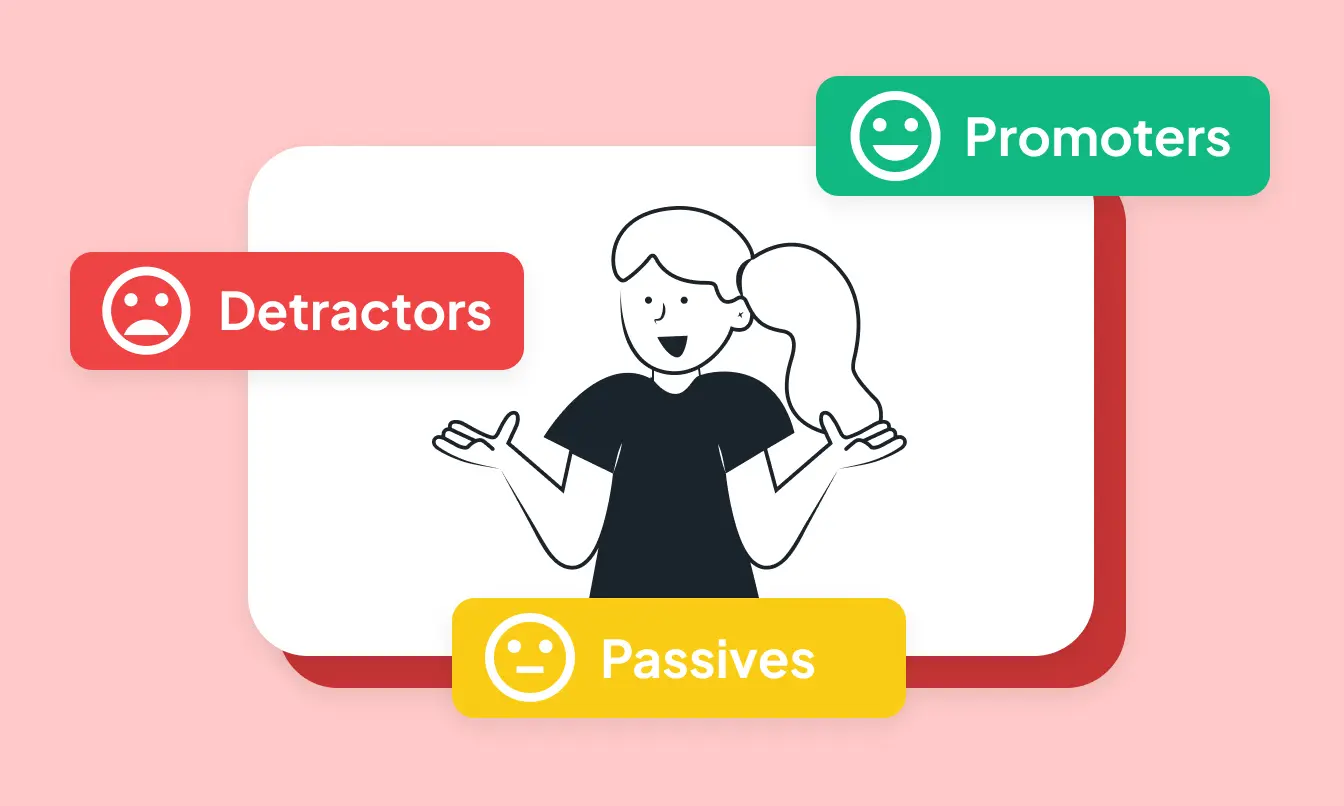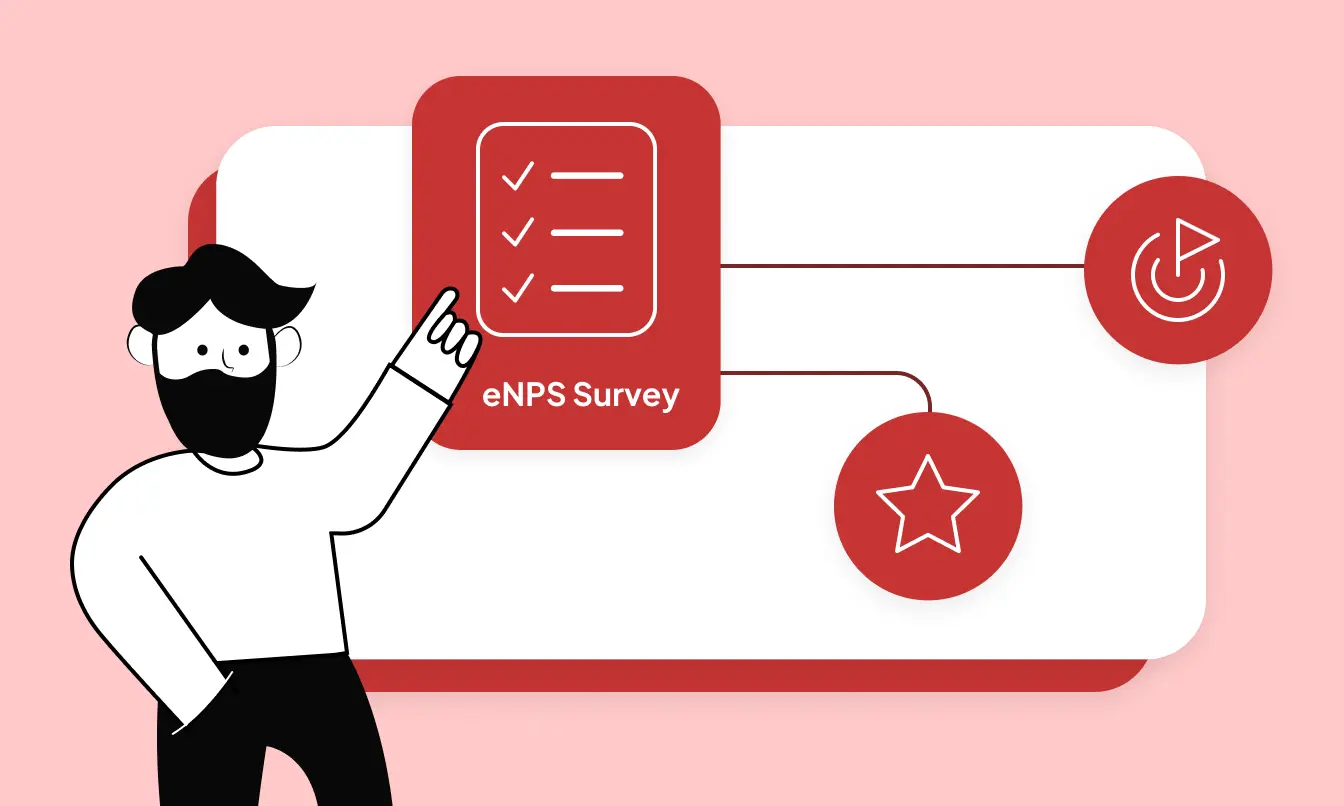
26 Insightful eNPS Questions To Ask Your Team


- The Central Question in eNPS Surveys
- Top Questions You Should Add To Your Next eNPS Survey
- Types of Questions In An eNPS Survey
- An eNPS Survey Template
- The Framework of a Well-structured eNPS Survey:
- What Role Does eNPS Play In Your Organization?
- Reach Excellency With agyleOS
- In Conclusion
Employee experience (EX) is an essential factor affecting your organization. Research shows that the more engaged the employees are, the more productive a company is.
Moreover, engaged employees are more likely to promote your organization as a workplace.
How should you evaluate your employee engagement and devotion?
One of the methods to measure employee satisfaction and loyalty is the Employee Net Promoter Score (eNPS). The eNPS helps an organization to have insights into its overall status.
However, the questionnaire for this survey is even more critical than eNPS itself.
What must you ask your employees for the perfect assessment?
Can a single question identify every possible threat concerning your organization?
Should you use the same eNPS question template other companies apply?
In this article, we will answer all your doubts and inquiries concerning the eNPS Survey Questions.
We will show you the importance of asking the right question and applying a thorough method.
Bear with us through this article to improve your company one step at a time.
Our Employee Survey Systems allow you to have specifically designed eNPS surveys to serve your company’s needs.
The Central Question in eNPS Surveys

A typical eNPS survey starts with this question: “On a scale of 0 to 10, How likely are you to recommend your organization as a workplace to others?”
Based on the answer to this question, employees are categorized into three groups:
- Promoters (9-10): Employees who are the most likely to recommend and promote their company.
- Passives (7-8): Employees who are generally satisfied but can also turn into detractors if treated improperly.
- Detractors (0-6): Employees who are the least likely to promote their company.
The score of an eNPS survey is calculated by subtracting the percentage of detractors from the percentage of promoters.
Hence, the higher the score, the more satisfying a company is for work.
If you still find it hard to figure out your organization’s score, you can take a look at our article “How to calculate eNPS”.
Top Questions You Should Add To Your Next eNPS Survey
Why is it essential to know what to ask? As Carl Jung stated, asking the right question is already half the solution to a problem.
You can only address an issue when you know of its existence. You will discover your organization’s crucial and potentially problematic issues by asking your employees the right questions.
All eNPS surveys start with a fundamental question: “On a scale of 0 to 10, how likely are you to recommend your company as a workplace?”
Although this question rates the level of retention and loyalty, for a better, fulfilling result, you should add at least one more follow-up question.
In the following, we have prepared a list of viable questions you can ask.
Get a copy of all the questions for offline access.
📥 Download Our eNPS Questionnaire PDF!
1. What is the primary reason for your score?
This open-ended question gives quality to the quantitative answers.
You can figure if the detractors have problems with their salary, work time, etc. Moreover, you can discover your fine areas by interviewing the promoters.
Case Study
The eNPS results of an organization show that 67% of employees who rated their workplace from 0 to 8 (Passives and Detractors) had unsettling thoughts about their work hours.
In this case, informed management took a step forward to address their issue by increasing overtime pay and making the hours more flexible.
The leadership also took the initiative to conduct these surveys regularly to check on the company’s process.
2. What should we do so you have a better experience?
By giving importance to the sentiment of your employees, they feel valued. Discover what they need:
fewer work hours, better services, paid overtime, etc. You can negotiate and compromise to reach an agreement with your team.
In the eNPS area, bear in mind that your company is your product, and your staff are the customers.
You can only grow if your workforce is determined to go the extra mile for your organization.
3. What is your favorite feature of our organization?
This question will help you find your company’s strong areas. If employees know you care about the part of the workplace they enjoy, they will be more engaged.
Additionally, once you have identified a potentially strong area, there’s nowhere to go but up.
You can achieve greater success and a good reputation by focusing on what highlights your company from the outside.
4. What is the main factor preventing you from recommending our company as a workplace?
With this question, you might receive some unpleasant answers, including complaints about lousy management, a toxic environment, low salaries, etc.
Still, it is essential that you know what parts of your organization make your employees uncomfortable.

5. Has the experience you have gained in our company over the past six months been valuable? (Yes/No)
Yes/no questions like this one deliver quantifiable answers. They help you realize if your company is on the right path, addressing a particular subject.
If an employee answers the presented question negatively, it indicates some potential issues with timing, resources, management, etc.
6. What is the main factor impacting your experience in our company?
This one is a follow-up question to the former.
By correcting your mistakes and improving your strengths, you can enhance the employee experience.
7. Do you see yourself still working with our company five years from now? (Yes/No)
This question can be followed by a ”Why/Why not?” to realize why you might lose your employees in the future.
Additionally, promoters will state their reason for sticking with you, which is a fact of advantage over your rivals.
8. Does your organization invest enough resources in employee experience?
The answers to this question are quantifiable. It could demonstrate whether or not most of your employees feel valued and heard.
What do we mean by “investing resources”?
Resources include everything your workforce needs to perform their job properly.
Whether they need specific equipment, different web accesses, or other organizational materials, you must provide enough resources for an acceptable job.
The eNPS is not an expensive survey to conduct, and it is very efficient. However, if executed poorly, it will result in shaky trust and loss of communication.
Failed employee engagement surveys, unanswered feedback, rigid communication, and other mismanagement factors will all lead to your employees’ lack of trust.
9. Has your manager been helpful or supportive in difficult situations?
Poor management is one of the leading causes of company breakdowns.
If your organization’s score on eNPS is low, you should conduct other surveys to locate the problems.
Case Study
A company has gone through a change in administration recently.
The new results of eNPS surveys indicate that the employees who rated 7 to 10 are more pleased with the extra management support.
In this case, the new leadership has gained a decisive advantage over the former since it handles challenges more efficiently.
10. How important is your health to your company?
As mentioned before, employees must feel valued and engaged in order for them to be productive.
If you, as an organization, don’t prioritize their well-being, they won’t prioritize their job.
11. On a scale of 0 to 10, how intriguing is your work?
This question might sound too personal to contain organizational insight.
However, it allows you to identify employees who are willing to do their best for the job.
To be perfectly candid, nobody loves a dull routine survey; by asking about employee enthusiasm, you could comprehend some underlying causes that frustrate your employees.
By identifying those causes, you’ll retain potentially excellent employees.
12. What was your primary reason for joining our company?
A candidate chooses you over competing companies because of your outstanding features.
This reason may be due to development chances, better benefits, higher salaries, etc.
Using your best feature, you can attract and engage employees more and more.
13. On a scale of 0 to 10, how do you rate your company’s performance compared to your expectations?
This somehow follows up on our previous question.
As a company, you should know if your performance matches your employees’ expectations.
Suppose a candidate chooses your organization based on paid overtime but is now dissatisfied with their job.
It would help if you looked into their complaints to reach a solution for retention.

14. Does our company value work-life balance enough?
15. Does our company have the capacity for professional growth?
16. Does our company value workplace culture and employee experience?
These three questions are area-focused: They help you comprehend specific workplace issues your employees might have.
Moreover, given the answers you have obtained, you can prioritize fixing an area more quickly.
Through these questions, you understand how different aspects of your organization operate.
For example, you might figure that even though your company offers an acceptable work-life balance, you fall short on professional growth opportunities, which is detrimental to prolonged collaboration with your staff.
17. On a scale of 0 to 10, how likely are you to apply for another company?
This quantifiable question will show how many employees think about leaving your company.
A high result for this question demonstrates possible underlying problems within your organization.
18. What is the main reason for you to leave your company for another organization?
This question is a follow-up to the previous one. You can work on your different features by viewing the strong aspects of your rival companies through your employees’ eyes.
All employees should answer this question regardless of their primary score.
Promoters’ insights (rating 9-10) may seem superficial or trivial to you at the time. But remember, it is easier to prevent massive issues at the beginning.
19. Does your company value your feedback when making changes? (Yes/No)
Listening to your employees’ input and treating them as an integral part of the company will make them more engaged and intrigued.
You can measure the number of confident and engaged employees with this question.
Creating a welcoming and safe atmosphere will make more employees feel confident to share their opinions.
You can show gratitude and respect by taking action based on their feedback.

20. Has your organization experienced any helpful changes in the past six months? (Yes/No)
The ability to change and improve makes a company stand out amongst its competitors.
Adjusting the circumstances to match the needs of the employees is vital.
If your staff confirms that you care about their needs and compromise to reach a mutual agreement, it indicates that they are loyal to your organization.
Nevertheless, some daunting changes may unsettle your staff, including rigid hours and reduced benefits.
Based on employee feedback, consider upgrading your internal communication systems to boost your company’s environment.
21. How do you rate the provided resources in your workplace?
Unlike some old beliefs, tricky situations and lack of resources make people disappointed rather than flourish.
If your employee needs specific equipment to do their job, you must provide them with that.
If your employees don’t have the resources to do their job correctly, they will get frustrated with their jobs.
You must provide your employees with enough equipment to fulfill your obligation and their purpose.
22. Question for detractors: What is your main obstacle to staying in your organization?
Detractors’ feedback about your company could help you identify your weakest areas.
If their issues are fixable, you should take action as soon as possible to keep your employees in your company.
Case Study
A company revealed that up to 50% of their detractors had problems with their salary.
In this case, the company could not give all of its staff a raise, so they conducted more profound research.
They analyzed their potential employees for promotion and identified those who could serve fewer work hours for the same salary.
The leadership of this company regularly applied eNPS surveys to see how the change affected the detractors.
Unsurprisingly, the conflict over salary took a dive after some time.
23. Question for passives: What are your workplace's best and worst parts?
Although passive employees’ percentages don’t affect the eNPS number, they are the ones who can quickly turn into detractors or promoters.
Passives make you objectively realize potential threats or growing areas since they are generally neutral about their workplace.
24. Question for promoters: What is the best aspect of your job in our organization?
Working on your strong points always pays off. Improving the workplace's positive aspects regarding your promoters’ feedback makes your workforce more engaged and productive.
By encouraging your excellent workers and enabling them to have free judgment, you have a better shot at engaged employees running around in your departments.
25. Do we appreciate and celebrate your work enough? (Yes/No)
Appreciating the employees’ engagement encourages them to be more productive.
Engaged employees will go the extra mile to achieve your company’s goals.

26. Do you have any other insights into our offerings? (that we haven’t covered in the survey)
Some trivial but important matters are easy to miss.
It is always crucial to ask and value your employees’ additional opinions.
For example, some employees might have concerns about their commute, family member perks, health insurance, etc.
You are obligated as their manager to address their rational demands.
Types of Questions In An eNPS Survey
We displayed and deployed 26 viable eNPS questions for your following questionnaire.
These questions are categorized into three classes for better comprehension. Knowing these categories helps you decide which questions are more suitable for your organization.
-
Digital scale questions:
These questions ask the employee to rate a specific topic on a scale of 0 to 10. This type of questionnaire is essential since the results are easily measurable and straightforward. -
Open-ended questions:
These types of questions are asked to consider the sentiments and honest views of the employees. The problems, weak points, and strong suits of a company are revealed through these questions. -
Yes/No questions:
These kinds of questions are quantifiable. You can ask them when you want to know how most of your employees feel about a general or specific area.
An eNPS Survey Template
A typical eNPS survey consists of one primary question: “On a scale of 0 to 10, how likely are you to recommend your workplace?” and a few more follow-ups.
The follow-up questions are specifically related to your organization or the employee’s answer to the former question.
For example, if an employee rates six on the satisfaction scale, you should ask them about the possible obstacles driving them away from your company.
The questionnaire should be uniform and unambiguous.
You can use the agyleOS Employee Survey System to apply an eNPS survey that serves your organization’s needs, In addition to cultural health checks for resilient company culture.
The Framework of a Well-structured eNPS Survey:

Besides the central question of every eNPS survey, “On a scale of 0 to 10, how likely are you to recommend your workplace?” some tips and a few more well-designed questions would craft a better, well-structured survey.
Note that the best surveys are the ones that are specifically designed for your organization’s needs and requirements.
We have a few suggestions for your organization to get the most practical results:
- Regularity: Consistent eNPS surveys and tracking the employee experience process help the company assess the changes properly.
- Anonymity: Employees must feel safe enough to express their true sentiments towards their workplace, management, etc. Anonymous surveys limit the employees’ fear of facing the consequences for their honest feedback.
- Simplicity and thoroughness: Surveys shouldn’t be long and tiresome. Otherwise, few people would bother doing them. An extensive but brief survey contains a leading question and 1 to 2 follow-ups.
- Clarity: the questionnaire must be well-written and clear. Ambiguity might cause confusion and frustration. To avoid any trouble, we suggest you use an eNPS survey template.
- Objectivity: You must avoid discrimination at all costs. Using neutral language and a neutral tone, besides keeping anonymity, is best.
- Create motivation: Expecting someone to answer a survey after long work hours isn't fair. It would be even worse if the survey platform were tedious and complicated.
You should adjust the timing of the survey and send out invite emails to all the targeted employees; for better results, you can also use reminder emails.
You can use the employee survey services of agyleOS to conduct a simple yet specifically designed survey.
What Role Does eNPS Play In Your Organization?
The employee net promoter score, or eNPS, is a measurement tool used to evaluate the satisfaction and loyalty of an organization’s employees. eNPS has evolved from the older Net Promoter Score (NPS), which is customer-focused.
NPS reviews the customer experience with a company's service or product, whereas eNPS measures the employee experience within that company.
If done correctly, eNPS and NPS would help a company achieve better profitability.
eNPS is an essential measuring tool for the employee experience. If you’re still uncertain about its benefits and nature, we recommend you read our article “What is eNPS?”
Reach Excellency With agyleOS
With agyleOS, we help you specifically conduct eNPS and other employee engagement surveys to have the healthiest workplace culture and a resilient organization.
agyleOS Features For Your eNPS Surveys:
Employees are the hallmark of a company. We craft special features for the experience of our employee survey system to make it smooth and pleasant.
Some of the features that are used in our employee survey systems are:
- Customized surveys to meet the unique needs of your organization.
- Enhanced employee engagement by conducting targeted surveys and taking action.
- Transparent developments to keep your team informed of your process and growth. You trust your team; they trust you.
- Visualized results such as insightful charts to share and interpret for a tangible experience.Dynamic survey comparison to track the development of the results over a period of time to plan better strategies.
- Dynamic survey comparison to track the development of the results over a period of time to plan better strategies.
In Conclusion
eNPS surveys help organizations analyze how engaged and devoted their employees are.
Choosing the right questions for an eNPS survey is a crucial act regarding how it would demonstrate the potential threatening issues.
If a company does regular eNPS surveys and actively takes steps to improve its employee experience, it will undoubtedly have better profit and productivity than its competitors.
By submitting this form, I confirm that I have read the privacy policy and that I consent to the processing of my personal data by agyleOS for the purposes stated. In the event of consent, I can revoke my consent at any time. Furthermore, by submitting the form, I agree to the general terms and conditions.


- Product
- Resources
- Compare
- Company
